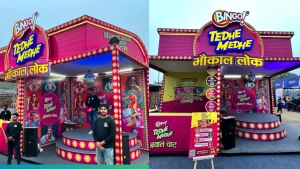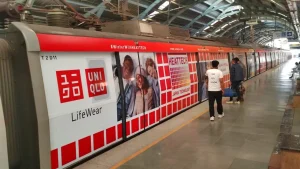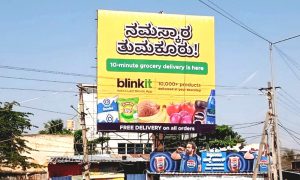The Future of Transit Advertising: Opportunities and Challenges
4 min read
Transit advertising, the practice of placing ads in or on modes of public transportation and within transit stations, has long been a staple in the advertising industry. As cities grow and public transportation networks expand, transit advertising presents unique opportunities for brands to reach a broad and diverse audience. However, like any advertising medium, it comes with its own set of challenges. Here’s a look at what the future holds for transit advertising and how businesses can navigate this evolving landscape.

Opportunities in Transit Advertising
- Expanding Reach in Urban Areas With urbanization on the rise, public transportation systems are expanding, offering advertisers increased opportunities to reach larger audiences. As more people rely on buses, trains, and subways for their daily commute, transit advertising can effectively target a captive audience that spends a significant amount of time in transit.
- Digital Transformation The integration of digital technology into transit advertising is opening up new possibilities for creativity and engagement. Digital displays, interactive screens, and real-time updates allow for more dynamic and personalized advertising. These advancements enable brands to tailor their messages based on time, location, and even current events, making transit ads more relevant and impactful.
- Targeted Advertising Transit advertising offers unique targeting opportunities based on geography and demographics. Advertisers can choose specific routes or stations to reach particular audience segments, such as targeting ads for luxury products on commuter trains serving affluent neighborhoods. This level of precision ensures that advertising budgets are spent efficiently and effectively.
- Sustainability and Eco-Friendly Initiatives As concerns about environmental sustainability grow, public transportation is increasingly seen as a green alternative to personal vehicles. Brands that align their messaging with sustainability themes can enhance their reputation by associating with eco-friendly transit options. Additionally, innovations in eco-friendly materials for ad displays contribute to a greener advertising approach.
- Innovative Formats The future of transit advertising will likely see the rise of more innovative formats, such as 3D installations, augmented reality (AR), and experiential marketing campaigns. These creative approaches can captivate audiences and create memorable brand experiences, standing out in the often cluttered advertising environment.
Challenges in Transit Advertising
- High Competition and Clutter As transit advertising becomes more popular, the space is becoming increasingly competitive. Advertisers must find ways to stand out in a crowded environment where multiple brands are vying for attention. This requires not only creative design but also strategic placement and timing to ensure maximum visibility and impact.
- Ad Fatigue Frequent exposure to ads in public spaces can lead to ad fatigue, where consumers become desensitized to the messages. To combat this, brands need to focus on creating engaging and relevant content that resonates with the audience rather than just adding to the noise.
- Measurement and ROI One of the biggest challenges in transit advertising is measuring the effectiveness of campaigns. Unlike digital advertising, where metrics like clicks and conversions are readily available, tracking the ROI of transit ads can be more complex. Advertisers need to invest in innovative tracking methods, such as mobile geolocation data, to better understand the impact of their campaigns.
- Regulatory and Operational Constraints Transit advertising is subject to various regulations and operational constraints, depending on the city or country. Restrictions on ad content, placement, and duration can limit creativity and effectiveness. Additionally, logistical challenges, such as maintaining and updating ads on moving vehicles, can increase costs and complexity.
- Changing Commuter Patterns The COVID-19 pandemic has had a lasting impact on commuter patterns, with more people working from home and fewer using public transportation. While transit systems are recovering, advertisers must adapt to these changes and consider hybrid strategies that combine transit advertising with digital and other out-of-home (OOH) formats.

Navigating the Future of Transit Advertising
To successfully navigate the future of transit advertising, brands must stay ahead of industry trends and be willing to innovate. Here are a few strategies to consider:
- Embrace Digital Integration: Invest in digital transit advertising to leverage dynamic content and real-time updates. Use data analytics to optimize ad placements and measure campaign success.
- Focus on Creativity: In a competitive environment, creativity is key. Explore innovative formats and interactive elements to capture attention and create memorable experiences.
- Sustainability Messaging: Align your brand with eco-friendly initiatives and use sustainable materials in your advertising efforts to resonate with environmentally conscious consumers.
- Adapt to Changing Commuter Patterns: Stay informed about changes in public transportation usage and be flexible in your approach. Consider combining transit advertising with other OOH and digital formats for a comprehensive strategy.
Conclusion
The future of transit advertising is filled with opportunities, but it also presents challenges that require careful navigation. By embracing digital transformation, focusing on creativity, and staying attuned to industry changes, brands can continue to leverage transit advertising as a powerful tool to reach and engage their target audiences.
For expert guidance on optimizing your transit advertising strategy, contact MyHoardings:
- Email: business@myhoardings.com
- Phone: +91-9953847639
- Website: www.myhoardings.com
Let us help you create impactful and memorable transit advertising campaigns!
Types of Transit Vehicle Branding
Type of Transit Media Advertising services – |






